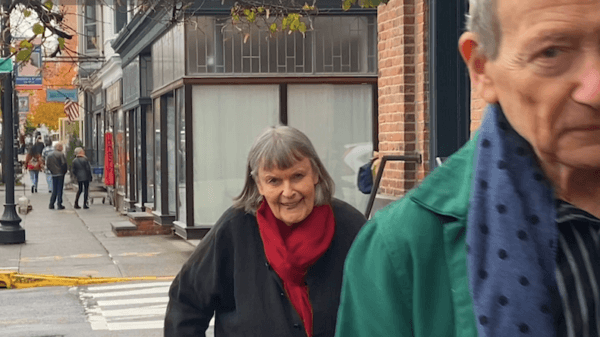Barons of Broadway #25
Hugh Maxwell, though largely forgotten today, was once among the most prominent and affluent individuals in Nyack’s history. His influence was so significant that the 1845 William Wade Panorama of the Hudson River Valley labeled Nyack solely with his name.

Maxwell’s three-story brick colonial-style home, built circa 1840, occupied the site of what is now Upper Nyack Elementary School. Local lore once claimed it had been constructed by a pirate smuggler, though this was untrue. The house, erected on the foundation of one of Nyack’s earliest farmhouses, marked the beginning of the trend where wealthy New York City elites built summer homes on Upper Nyack farmland. Maxwell’s house later served as a clubhouse for the Nyack Country Club and Pierre Bernard’s yoga ashram, the Clarkstown Country Club.

Early Settlers and the Knapp-Lydecker House
The history of the land Maxwell acquired dates to 1739 when Cornelius Kuyper, Nyack’s first Dutch settler, owned all 640 acres of Upper Nyack. Upon his death, the property was divided into six east-west strips. Benjamin Knapp purchased one of these, a 220-acre tract, before 1762. The property changed hands multiple times, passing through the Knapp and Lydecker families before Maxwell’s purchase in 1838.

The Knapp family built a modest Dutch-style stone house, later replaced by a more substantial structure during John Lydecker’s ownership (1800–1836). Lydecker, a Jacksonian Democrat and influential local figure, lived in what became known as the “Old Squire’s” house.
The Life and Career of Hugh Maxwell
Born on June 16, 1787, in Paisley, Scotland, Maxwell immigrated to America with his family at the age of three. After graduating at the top of his class from Columbia University in 1808, Maxwell began a distinguished legal career. His advocacy for justice was evident even as a student, leading a free speech protest at Columbia that resulted in a $200 fine and legal proceedings.

Maxwell’s legal career gained momentum when James Monroe appointed him Assistant Judge Advocate of the U.S. Military during the War of 1812. He later served as New York City’s District Attorney (1819–1829), prosecuting high-profile cases, including a fraud trial against prominent Tammany Hall figures. Maxwell’s refusal to apologize to a shipbuilder defendant in one such case earned him a duel challenge, which he ignored, cementing his reputation as a man of principle.

Zachary Taylor, President


In 1849, President Zachary Taylor appointed Maxwell the 11th Collector of the Port of New York, a role he fulfilled with integrity despite its notorious history of corruption. The position, located in the Federal Building in 1850, proved to be lucrative for many. Later, eventual President, Charles A. Arthur, earned $1M per year as Collector.

Maxwell’s Estate House
Maxwell spared no expense in constructing his Colonial-style brick mansion, likely incorporating stones from the original Knapp farmhouse as part of its foundation. Built around 1840, the three-story structure was the largest home in the Nyacks at the time. With symmetrical front and sides, the house included a wide veranda, later expanded. A wing with porches jutted to the rear of the house. A circular driveway led from the small dirt road then known as the Road to the Hook and later North Broadway to a porte cochere on the southern side.

Inside, Maxwell’s house was as opulent as it was scholarly. Known for his deep love of literature, he filled his summer home with a remarkable library containing works by Homer, Plato, Shakespeare, Milton, and Burns. This library likely served as the intellectual centerpiece of the house, reflecting Maxwell’s education and tastes. While the precise layout of the home is not documented, it was undoubtedly designed for both comfort and aesthetic appeal, with elegant furnishings and ample space for hosting gatherings.

The Maxwell Farm
The house also included features befitting Maxwell’s wealth, such as polished wood floors, fireplaces for warmth, and possibly ornate moldings typical of high-end Colonial-style homes. Maxwell’s commitment to creating a refined retreat extended to the surrounding gardens, which were likely landscaped to complement the grandeur of the home.
While the mansion symbolized Maxwell’s social status, the surrounding farmland emphasized his connection to the agricultural roots of the area. Covering roughly 80 acres, the estate included 50 acres of fields and 30 wooded acres, making it one of the most expansive properties in the region.

The farm produced wheat, rye, and Indian corn, essential crops for sustaining both the household and local markets. Livestock on the property included three horses, five milk cows, and eleven pigs. Maxwell’s inventory also listed luxury items such as a one-horse carriage, a two-horse carriage, and 20 pounds of silver plate, underscoring his affluence.

Staffing the Estate
Maintaining such a large estate required a dedicated staff. Two workers managed the agricultural aspects of the farm, while four Irish maids handled domestic tasks within the house. Emeline, the wife of Peter Williamson who was born enslaved on the nearby Williamson farm, became a trusted maid in the Maxwell home.
The staff ensured the smooth operation of the estate, from harvesting crops to maintaining the house’s pristine condition. Maxwell himself remained active, frequently seen riding his horse into town well into his 80s.
A Summer Sanctuary
The Maxwell estate served as a sanctuary for Hugh Maxwell, offering respite from his demanding public career in New York City. He spent his summers in Nyack, immersed in reading and enjoying the tranquility of his expansive property. The house was a place where he could entertain friends, relax with his family, and engage in intellectual pursuits.
Agnes Maxwell’s Scandalous Romance with General Philip Kearny

For all of Hugh Maxwell’s probity, his family faced a very public scandal. Agnes Maxwell, Hugh Maxwell’s youngest daughter, became embroiled in a romantic scandal that captivated high society in the mid-19th century. While visiting Paris in 1852, the 20-year-old Agnes met General Philip Kearny, a dashing cavalry officer 19 years her senior. Kearny was already married with four children, yet his charm and larger-than-life reputation captivated Agnes.
Agnes and Kearny Ignore Social Norms


Kearny, known for his service with the French cavalry in Algeria, had earned the nickname Kearny le Magnifique for his bravery and flamboyant style. He was said to ride into battle with a sword in one hand, a pistol in the other, and reins clutched in his teeth. Upon returning to the United States, he served with distinction in the Mexican-American War, where he lost his left arm leading a daring charge at the Battle of Churubusco. Despite this injury, he remained a fearless and celebrated military leader.
By 1854, after a horseback accident left Kearny temporarily incapacitated, Agnes moved in to nurse him back to health. Their close relationship caused an uproar in society circles, and Hugh Maxwell, furious at the potential damage to the family’s reputation, sent Agnes’s brother, Hugh Jr., to Paris to retrieve her. However, the siblings returned together on their own terms, taking up residence on Kearny’s estate in Passaic, New Jersey.

In 1858, Kearny divorced his wife, and shortly thereafter, he and Agnes married in Paris. Their union produced two children, though one died young. In 1861, as the Civil War erupted, Kearny returned to military service as a Union general. His daring leadership in several battles, including the Peninsula Campaign and Second Bull Run, earned him admiration and notoriety.

Tragically, Kearny died on September 1, 1862, during a retreat after the Battle of Chantilly. A Confederate soldier shot him as he mistakenly rode into enemy lines in poor visibility. Despite the scandal surrounding their relationship, Kearny’s valor left a lasting legacy, with Kearny, New Jersey, and Fort Kearny in Virginia named in his honor.

Agnes later remarried Commander John Upshur, a Union naval officer and cousin of Robert E. Lee who chose to remain loyal to the North. They settled in Washington, D.C., where Agnes lived until her death in 1917. She was buried in Arlington National Cemetery.

Maxwell’s Will: A Legacy of Endless Litigation
Hugh Maxwell’s death in 1871 marked the beginning of a decades-long inheritance battle that mirrored the complexities of a Dickens novel. Maxwell, a wealthy and influential man, left behind substantial assets, including his summer estate in Nyack, his Manhattan residence, and other holdings. These were valued at approximately $150,000 at the time (equivalent to around $34 million today).

The inheritance initially seemed straightforward, but the situation became convoluted as Maxwell’s children and their descendants passed away, each leaving wills that further splintered the estate.
A Complicated Family Dynamic
Hugh and his wife, Agnes Stevenson, had four children:
- John Stevenson Maxwell (1816–1870): Died a year before Hugh, complicating his share of the inheritance.
- Ann Eliza Maxwell (1817–1888): Her will named multiple beneficiaries, including cousins and friends, adding layers of claimants to the estate.
- Hugh Maxwell Jr. (1823–1898): His death triggered yet another reevaluation of the will.
- Agnes Maxwell (1832–1917): The only child alive by the time of the final estate settlement.

Each death brought new legal challenges. When Ann Eliza passed away in 1888, her will included provisions for three cousins, three friends, a daughter, and two grandchildren. This fragmented the inheritance further, forcing the estate into prolonged litigation.
Legal Battles and Missed Settlements
The first major legal dispute occurred in 1897, when Agnes Maxwell sued 18 individuals, including her own brother, Hugh Jr., and her husband, John Upshur. During this case, lawyers discovered that the executor of Hugh Maxwell’s will had overlooked a critical flaw in the document, throwing the inheritance into further chaos.
The case temporarily resolved through a partition settlement, which divided the estate among multiple heirs. However, just as the family prepared to sell the Nyack property to Clyde Brainard in 1899, Hugh Jr. and his daughter died within days of each other. Their deaths reopened the settlement process, forcing another round of lawsuits and delays.
The Final Sale

Not until 1902—over 30 years after Hugh Maxwell’s death—did the Nyack estate finally sell at auction to Van Wyck Rossiter for $20,000. Rossiter built a Tudor-style residence on the property, which is now the Nyack Field Club.
During the interim, the Maxwell estate saw various uses. By the late 1880s, the mansion served as a boarding house managed by Mrs. Powell, and in 1890, it became the home of the Nyack Country Club. The club remained there until the end of World War I. Subsequently, Pierre Bernard’s Clarkstown Country Club purchased the property making their initial foray into Nyack.
We look at these two eras in the next episode of Barons of Broadway.
Mike Hays lived in the Nyacks for 38-years. He worked for McGraw-Hill Education in New York City for many years. Hays serves as President of the Historical Society of the Nyacks, Vice-President of the Edward Hopper House Museum & Study Center, and Upper Nyack Historian. . Married to Bernie Richey, he enjoys cycling and winters in Florida. You can follow him on Instagram as UpperNyackMike.
Editor’s note: This article is sponsored by Sun River Health and Ellis Sotheby’s International Realty. Sun River Health is a network of 43 Federally Qualified Health Centers (FQHCs) providing primary, dental, pediatric, OB-GYN, and behavioral health care to over 245,000 patients annually. Ellis Sotheby’s International Realty is the lower Hudson Valley’s Leader in Luxury. Located in the charming Hudson River village of Nyack, approximately 22 miles from New York City. Our agents are passionate about listing and selling extraordinary properties in the Lower Hudson Valley, including Rockland and Orange Counties, New York.









